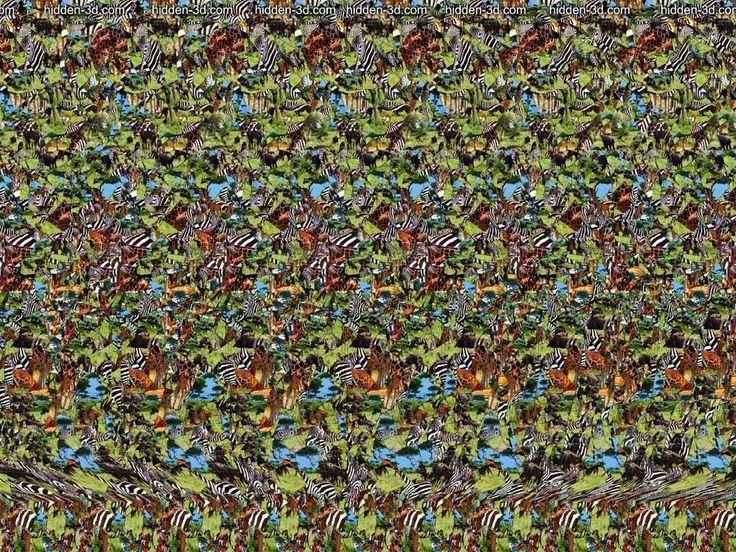I used to have 3D posters on my wall as a kid, today I found out they are called sterograms... who knew that!??
Anyways here is a bit about them and how they work. Some people can see them right away, it takes me a few moments to piece the photo together.
Come to find out these 3d pics were created way back in 1838, and I thought they were modern, from the 60's or 70's.
Here are a few 3D sterograms for you and some info on how to view them :-)

A Stereogram is an optical illusion of depth created from a 2D image.
Stereograms were discovered by Charles Wheatstone in 1838. He created the first stereoscope based on a combination of mirrors that allowed a person to see a 3D image from 2 slightly different 2D pictures.
The most simple stereograms are autostereograms, created from models that repeat horizontally. When the image is viewed correctly those images appear to float above the background.

This 3D illusion is created by repeating the rider every 140 pixels, the shark at every 130 pixels and the tiger at every 120 pixels. The closer a set of images are, the higher they are lifted from the background. The brain is capable of almost instantly match hundreds of similar images repeated at different intervals to create the 3D image.
Another stereogram is the single image random dot stereogram (or SIRDS). Each point is computed based of a depth map and projected against a series of random dots.
We can use a repeating pattern instead of the random dots. We will get a wallpaper stereogram which, looked correctly, will show the hidden image. The important thing is that the pattern should not have big horizontal colorless areas. It has to be as much as colored as possible.
The subtle changes in the distance between the stereogram points can create the illusion of a continuous passing in depth. Each color in the depth map is translated in a certain distance between the points on the resulting image.
This type of stereogram assumes a more dynamic image, with lots of color variations. The easiest model is to use random dots. We can also use repetitive patterns if those patterns don’t have big horizontal monotonic patches.
This depth map is the most important part of a stereogram. We cannot generate a neet stereogram unless we have a very good depth map. And, unfortunately, those are the hardest to create. We can generate them using some 3D modeling programs like 3D Studio.
The mask must be an image in black and white, where black is the background and the different shades of white represent points floating above the background. The whiter the points, the closest the points are to you.
You can also create them by simply making a white shape on a black background. Off cource, this will not have any depth variations at all.
Technical details on how to see a stereogram
We have 2 eyes at 15 cm between. This is why when we look into the real world each eye sees the world from a slight different angle as the other.
In the beginning, the idea behind the making of stereograms was to show each eye a different image. The brain gets the 2 images, interprets them and creates the depth feeling.
There are two methods for viewing a stereogram: parallel viewing and cross-eyed viewing method. Most of the stereograms are made to be seen in a single way – parallel way. This view technique requires that the eyes take a relative parallel angle and focus somewhere behind the image. Cross-eyed viewing asumes that the viewer focuses his eyes in front of the picture - this is where the name commes, the viewer has to cross his eyes.
The big question is "How can I see that?!"

The first thing you need to know is that not everybody can see the 3D illusion in a stereogram. The persons with visual impairments affecting one or both eyes can't see the 3D illusion.
While some of us can simply see the 3D image hidden in a stereogram, most of us have to train our eyes to see the illusion.
How to view a 3D Stereogram
Bring the stereogram image really close to your eyes (until you touch it with your nose). At this distance your eyes cannot focus on the image and they look somewhere behind the image. Now, slowly push the image away from you, while trying to keep the eyes off focus. At some point you will see the hidden image.
Another method is to take an object and put it behind the image (about half of meter behind it). Now, focus on the object behind the image while keeping the eyes looking at the image.
Do you remember how is the feeling when you are drunk? Your eyes don't look at the object arround you, but rather through them. Well, this is actualy what we are trying to achive (look through the object, not get drunk, loll). If you can manage to get your eyes off focus, at some point you will be able to see the hidden image.
If you're not train to look at stereograms, this might take you some time.
First time I've looked at a stereogram it took me like an hour to finally be able to focus the eyes correctly to see the 3D image.
I find its easy just to relax my eyes and try to see a shape...
I hope you enjoyed this interesting bit about our eyes and interesting technology.
What do you see in the green photo? Comment below and I will tell you if you are right.

Thanks for reading! :-)
- David

